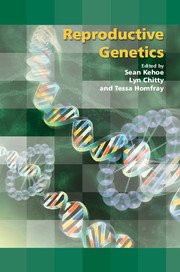Book contents
- Frontmatter
- Contents
- Participants
- Declarations of personal interest
- Preface
- 1 Genetic aetiology of infertility
- 2 Disorders of sex development
- 3 Preimplantation genetic diagnosis: current practice and future possibilities
- 4 Ethical aspects of saviour siblings: procreative reasons and the treatment of children
- 5 Epigenetics, assisted reproductive technologies and growth restriction
- 6 Fetal stem cell therapy
- 7 Prenatal gene therapy
- 8 Ethical aspects of stem cell therapy and gene therapy
- 9 Fetal dysmorphology: the role of the geneticist in the fetal medicine unit in targeting diagnostic tests
- 10 Fetal karyotyping: what should we be offering and how?
- 11 Non-invasive prenatal diagnosis: the future of prenatal genetic diagnosis?
- 12 Non-invasive prenatal diagnosis for fetal blood group status
- 13 Selective termination of pregnancy and preimplantation genetic diagnosis: some ethical issues in the interpretation of the legal criteria
- 14 Implementation and auditing of new genetics and tests: translating genetic tests into practice in the NHS
- 15 New advances in prenatal genetic testing: the parent perspective
- 16 Informed consent: what should we be doing?
- 17 Consensus views arising from the 57th Study Group: Reproductive Genetics
- Index
11 - Non-invasive prenatal diagnosis: the future of prenatal genetic diagnosis?
Published online by Cambridge University Press: 05 February 2014
- Frontmatter
- Contents
- Participants
- Declarations of personal interest
- Preface
- 1 Genetic aetiology of infertility
- 2 Disorders of sex development
- 3 Preimplantation genetic diagnosis: current practice and future possibilities
- 4 Ethical aspects of saviour siblings: procreative reasons and the treatment of children
- 5 Epigenetics, assisted reproductive technologies and growth restriction
- 6 Fetal stem cell therapy
- 7 Prenatal gene therapy
- 8 Ethical aspects of stem cell therapy and gene therapy
- 9 Fetal dysmorphology: the role of the geneticist in the fetal medicine unit in targeting diagnostic tests
- 10 Fetal karyotyping: what should we be offering and how?
- 11 Non-invasive prenatal diagnosis: the future of prenatal genetic diagnosis?
- 12 Non-invasive prenatal diagnosis for fetal blood group status
- 13 Selective termination of pregnancy and preimplantation genetic diagnosis: some ethical issues in the interpretation of the legal criteria
- 14 Implementation and auditing of new genetics and tests: translating genetic tests into practice in the NHS
- 15 New advances in prenatal genetic testing: the parent perspective
- 16 Informed consent: what should we be doing?
- 17 Consensus views arising from the 57th Study Group: Reproductive Genetics
- Index
Summary
Introduction
Current prenatal diagnosis of fetal genetic status or aneuploidy depends on the use of the invasive diagnostic tests amniocentesis and chorionic villus sampling (CVS), which carry a small but significant risk of miscarriage. For many years, researchers have sought alternative sources of fetal material on which to base genetic prenatal diagnosis. It was initially thought that fetal cells in the maternal circulation would fulfil this role but it is now recognised that this approach is unlikely to be clinically useful because of the scarcity of these cells and the inability to analyse them reliably. The identification of cell-free fetal DNA (cffDNA) in both maternal plasma and serum offered potential as an alternative source of fetal genetic material for prenatal diagnosis when molecular determination of fetal sex was achieved using the Y-chromosome-derived gene TSPY, found in the DYS14 marker sequence using a nested polymerase chain reaction (PCR). Lo's group then went on to show that cffDNA can be detected in maternal plasma from 4 weeks of gestation and is cleared rapidly from the maternal circulation after delivery, making it a potentially ideal source of fetal material for prenatal diagnosis. It is now thought that cffDNA emanates from the placenta as normal levels of cffDNA have been reported in anembryonic pregnancies. However, the vast majority of cell-free DNA (cfDNA) in the circulation is maternal in origin. It was initially estimated that cffDNA constitutes around 3% of total cfDNA in maternal plasma, rising to 6% towards term, but recent studies using deep sequencing and digital PCR methods suggest that the concentration may be as high as 19%.
Keywords
- Type
- Chapter
- Information
- Reproductive Genetics , pp. 159 - 172Publisher: Cambridge University PressPrint publication year: 2009



